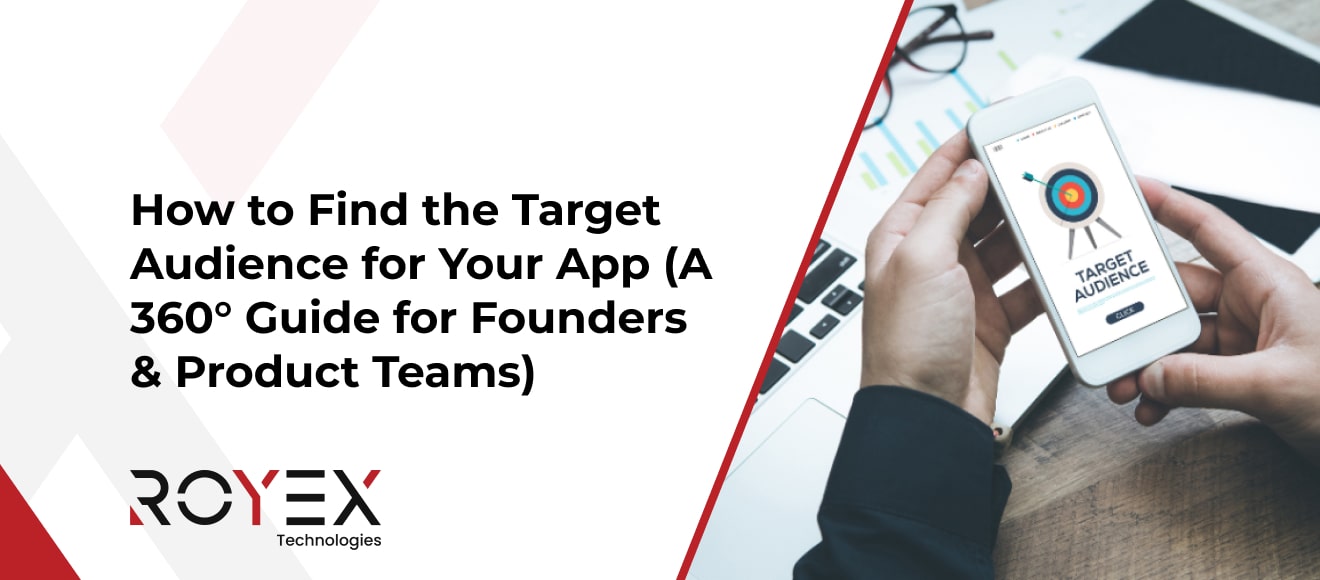
How to Find the Target Audience for Your App (A 360° Guide for Founders & Product Teams)
Series note: Based on common questions asked by our customers before developing mobile apps, we have listed most of the questions and answers in detail for each topic. This article is part of our series “Mobile App Journey: Things You Must Know.”
Why “target audience” is a make-or-break decision
The fastest way to waste money on app development is to build for “everyone.” The second fastest way is to build for “people like me.” Neither is a strategy.
Your target audience determines what you build, how you message, where you acquire users, which devices you optimize for, how you price, and what you measure. The stakes are high: post-mortems of failed startups continue to show that lack of real market need (which is another way of saying “we aimed at the wrong people—or nobody in particular”) is the #1 reason ventures shut down. (CB Insights)
At the same time, the opportunity is massive and getting noisier. Depending on the dataset, people spend 3–5+ hours per day in apps and global in-app spend keeps growing—even as installs and overall time fluctuate by market. (Sensor Tower) Benchmarks also remind us the funnel is unforgiving: median Day-1 retention sits around ~24–28%, sliding into single digits by Day-30—so if you target the wrong users, they churn fast. (Adjust)
This guide gives you a complete, step-by-step playbook to define, find, test, and refine your target audience—backed by methods you can run this month and stats you can use in stakeholder conversations.
The foundation: what “target audience” really means
Target audience ≠ a vague demographic (e.g., “18–45 in the US”). It’s a tight hypothesis that combines:
- Who they are (demographic & firmographic basics)
- Where and how they live online (channels, devices, geos, technographics)
- What jobs they “hire” your app to do (JTBD)
- Pain intensity and frequency (problem power)
- Behavioral signals (habits, purchase drivers, price sensitivity)
Your goal is to transform this from a guess into a validated, evolving profile you can acquire, retain, and monetize.
Step 1 — Start with the job, not the person (JTBD framing)
People don’t “buy apps.” They hire them to get jobs done. Reframe your audience hunt around the Job to Be Done (JTBD):
- “Track and stick to a 30-minute daily workout even when traveling”
- “Split restaurant bills instantly without awkward math”
- “File field reports with photos in <60 seconds, even offline”
Write 3–5 JTBD statements, each with situation → struggle → desired outcome. This shifts your thinking from generic personas to contexts where motivation is hottest.
Outcome: A shortlist of jobs that your early product can nail better than alternatives.
Step 2 — Map the market size and direction (TAM/SAM/SOM + trends)
Before zooming in, check there’s a “there” there.
- TAM/SAM/SOM:
-
- TAM (Total Addressable Market): everyone with the job/problem.
- SAM (Serviceable Available Market): people reachable on your platforms/geos.
- SOM (Serviceable Obtainable Market): your realistic capture in 12–24 months.
- TAM (Total Addressable Market): everyone with the job/problem.
- Trend sanity checks:
- App time and spend remain huge globally. Sensor Tower’s 2025 snapshot cites 4.2 trillion hours spent in apps in the past year, with consumer spend reaching $150B. (Sensor Tower)
- But growth is uneven: in the US, downloads dipped while spend rose 16%—signals to expect fiercer competition for attention but willingness to pay for value. (Investopedia)
- App time and spend remain huge globally. Sensor Tower’s 2025 snapshot cites 4.2 trillion hours spent in apps in the past year, with consumer spend reaching $150B. (Sensor Tower)
Outcome: Confidence that your niche has real, durable demand—and clarity on the slices you can actually reach.
Step 3 — Segment intelligently (beyond “age and gender”)
Use multi-layer segmentation to avoid generic targeting:
Demographic/Firmographic
- B2C: age bands, income, family status, education, city tier
- B2B: company size, industry, decision-maker function, tool stack
Psychographic
- Values, aspirations (e.g., “biohacker,” “budget optimizer,” “time-starved parent”)
Behavioral
- Past purchases, session patterns, cohort behaviors, content affinity
Technographic
- Device mix (Android/iOS share), OS versions, data plans, connectivity norms
Situational
- Commuting, traveling, seasonal spikes, regional events (e.g., Ramadan shopping patterns in GCC)
Tip: Start with 2–3 segments that overlap high pain + high frequency + reachable channels.
Why it matters: If your CPI benchmarks range $1.75–$4.50 per install (and much higher for certain verticals/platforms), every bit of precision saves budget. (Business of Apps)
Step 4 — Mine competitors’ audiences (ethical “fast follow” research)
Competitors are free user research:
- App store reviews: scan recurring complaints/desires to infer who’s using the app and what they value or hate.
- Pricing & packaging: who are they implicitly targeting (students, families, SMBs)?
- Ad libraries & creatives (Meta Ad Library, TikTok Creative Center, Google Ads): note messaging angles and audience assumptions.
- Category benchmarks: fintech, casual gaming, health and education show very different retention/install patterns; calibrate expectations. (Adjust)
Outcome: A table of gaps (underserved sub-audiences or needs) you can own.
Step 5 — Talk to humans (and do it right)
Run a quick, rigorous interview plan:
- Recruit 10–15 people who match your segment hypotheses (avoid friends/family bias).
- Ask contextual, open questions:
-
- “Walk me through the last time you tried to ___.”
- “What did you try? What broke? What did you do next?”
- “If you had a magic wand, what would be different?”
- “Walk me through the last time you tried to ___.”
- Avoid pitching; collect language and triggers you’ll later mirror in ads and onboarding.
Supplement with a lean survey to size patterns, but prioritize stories over scores at the start.
Why now? Because the retention cliff is real: global Day-1/7/30 retention often ~26–28% / ~13–18% / ~7–8%; targeting on assumptions just feeds the churn. (OneSignal)
Step 6 — Build proto-personas & ICPs (and make them “operational”)
Create two artifacts that your team will actually use:
Proto-Persona (B2C)
- Name + a real photo (stock is fine)
- Situation (“returns to office 3 days/week; 45-min commute”)
- Triggers (“feels guilty missing workouts; wants 20-min options”)
- Objections (“hates subscriptions; doesn’t trust calorie math”)
- Channels (“TikTok for fitness hacks; Reddit r/xx”)
- Devices (“Android mid-tier; limited data plan”)
ICP (Ideal Customer Profile) (B2B)
- Company traits (50–250 staff, field ops, uses Microsoft 365)
- Buyer + user roles, compliance hurdles, budget cycles
- Must-win pains (“photos + notes offline; zero-training rollout”)
Operationalize them by linking copy, creatives, onboarding flows, and pricing to each persona/ICP. Don’t let them collect dust.
Step 7 — Quantify where your audience lives (channels & devices)
Turn hypotheses into reach plans:
- Channels: Search (intent), social (interest), communities (trust), influencers (authority), partnerships (distribution).
- Devices & OS: In many markets Android dominates, but the CPI and monetization mix differs (iOS CPIs frequently higher in many verticals). Plan creative/testing strategy accordingly. (Liftoff)
- Geography & language: Localize early if your value is contextual (e.g., offers, transit, payments).
Stat to remember: Smartphone usage is gigantic—but ownership and usage patterns vary by region. Some sources estimate 4.9–6.8B smartphone users and 7.2B devices in circulation; penetration and device capability differ widely. Target with that nuance. (BankMyCell)
Step 8 — Validate with low-risk experiments (traction before code)
Prove you can reach and move your audience before you over-build:
- Landing page + waitlist with value proposition variants per segment
- Ad smoke tests (small budgets across 3–4 audiences; measure click-through and sign-ups)
- Lead magnets (checklists, short email course) aligned to your app’s job
- Price sensitivity probes (compare sign-ups across $0 / $4.99 / $9.99 positioning)
What “good” looks like: You see consistent sign-ups from one or two segments with messages tied to the job they care about most. (Exact thresholds vary, but even a 1–3% landing-page conversion from qualified traffic can be a strong early signal.)
Step 9 — Prototype onboarding for the audience you “won”
Once a segment bites, use clickable prototypes to ensure your first-run experience matches their mental model:
- Clarify benefit → action (“2 taps to log a 20-min workout”)
- Remove permission friction (ask for push/location only when the value is obvious)
- Add micro-copy in the person’s words (harvested from interviews/reviews)
This is where many apps lose the plot: even if you find the right people, a generic first-run flow will hemorrhage them at the front door—contributing to those low Day-1 and Day-7 benchmarks. (Adjust)
Step 10 — Launch a narrow MVP and measure cohorts by audience
When you ship, instrument everything by audience:
- Track activation events tied to the core job
- Compare D1/D7/D30 retention by segment and channel
- Measure CPI/CAC vs. LTV at segment level (not just blended)
- Run message-market fit surveys after “aha” moments
Remember that CPI varies widely by platform/genre and can spike quickly; segment-level efficiency helps you keep acquisition profitable as you scale. (Business of Apps)
B2C vs. B2B: different paths to the audience
For B2C apps
- Lean on JTBD + psychographics; find “tribes” (runners, creators, students).
- Channels: creators/influencers, TikTok/Instagram, app store optimization (ASO), communities (Discord, Reddit).
- Signals: organic share rates, UGC volume, retention lift after community exposure.
For B2B/Workforce apps
- Define an ICP with budget authority + daily users.
- Channels: LinkedIn, partnerships (ISVs, SIs), app marketplaces (Microsoft, Salesforce), field pilots.
- Signals: pilot ROI (time saved, error reduction), admin satisfaction, security/compliance acceptance.
International & regional nuance (UAE/GCC example)
In the GCC, device, language, and payment preferences can differ:
- Device mix: premium iOS share is strong in many urban segments; Android remains critical for breadth.
- Payments: support Apple Pay/Google Pay, local wallets, and cash-on-delivery norms for commerce.
- Seasonality: Ramadan can shift habits for food, fitness, and retail; plan creative and offer calendars accordingly.
Building your audience model with regional behavior in mind materially improves your CPI and retention.
What to do when you “have two audiences”
Many apps straddle two-sided markets (e.g., riders & drivers; creators & viewers). The rule of thumb:
- Sequence, don’t split. Start with the side with stronger motivation (higher pain + immediate value).
- Build tools that attract the other side (e.g., creator utilities that produce content viewers want).
- Launch geographically narrow to ensure density.
Advanced: audience science for scaling teams
- Event Taxonomy & Source of Truth: define events (Activation, “Aha,” Core Action) and tag users by audience from day one so dashboards show segment health.
- Lift tests over attribution wars: when channels fight over credit, run holdouts to measure true incremental lift by audience.
- Cross-device funnels: if your audience spans web + app, track both and tailor the app as the “retention engine” while web handles first-touch education.
Common mistakes (and how to avoid them)
- Persona theater: pretty slides, no behavioral proof. Fix: run smoke tests and prototype studies per persona.
- Fishing where you hang out: founders target their own networks. Fix: recruit from audience-native communities.
- Blended metrics: channel/segment averages hide gold. Fix: cohort by audience.
- Premature broadening: targeting everyone after early wins. Fix: saturate one wedge before expanding.
- Ignoring device realities: shipping “iPhone-perfect” flows to low-RAM Androids. Fix: test on representative hardware.
What good looks like (signs you’ve found “your people”)
- Acquisition: CPIs stabilize or fall for a segment as creatives “click” with their language. (Business of Apps)
- Activation: a growing share of new users hits the core action within the first session.
- Retention: D1/D7 trend up release over release for that audience, even if blended numbers wobble. (OneSignal)
- Monetization: conversion lifts are concentrated in the well-defined segments you designed for.
- Referral: organic invites show up in those cohorts without paid nudges.
Statistics to keep on your wall
- #1 Failure Reason: “No market need” remains the leading cause of startup failure → stay audience-obsessed. (CB Insights)
- Time in Apps: Users spent 4.2 trillion hours in apps last year; spend topped $150B → there’s money in solving real jobs. (Sensor Tower)
- Daily Phone Time: Averages range ~3–5 hours/day in apps (varies by country), confirming the fight is for relevance, not existence. (MobiLoud)
- Retention Cliff: Global Day-1 ≈ 24–28% | Day-7 ≈ 13–18% | Day-30 ≈ ~7–8% → wrong audience = instant churn. (Adjust)
- Acquisition Cost: Global CPI often $1.75–$4.50 (varies wildly by platform/vertical) → precision pays. (Business of Apps)
- Platform Nuance: iOS CPIs are frequently higher than Android in many genres (sometimes dramatically in gaming) → adjust bids & creative by audience + platform. (Liftoff)
Why Royex is a strong partner for audience-first app success
Choosing a partner that treats “target audience” as a discipline, not a slide, changes outcomes. Here’s how Royex Technologies helps:
- Audience Discovery Workshops
We run structured sessions to transform fuzzy ideas into JTBD statements, proto-personas, and ICPs, aligned to your business model. - Evidence-driven validation
We design and execute smoke tests, landing pages, and creative sprints, then read the data with you (sign-ups, CPL/CPI, segment resonance). - Prototype-to-MVP with audience in mind
Our designers and engineers build small-but-complete MVPs and onboarding that echo the language and triggers your audience used in interviews and reviews. - Analytics wired from day one
We instrument event taxonomies, cohort dashboards, and funnel alerts segmented by audience so you can iterate with clarity—not guesswork. - Regional fluency (UAE/GCC + global)
From device mix and payment norms to seasonal behavior (e.g., Ramadan), we tune acquisition and product flows to the contexts your audience actually lives in. - Post-launch growth
We help you expand wedges—from the first persona to adjacent segments—without breaking performance.
A practical 30-day plan you can start now
Week 1: Hypothesize & Prepare
- Draft 3–5 JTBD statements; choose 2–3 segments.
- Build a quick landing page with 2–3 message variants.
- Prepare interview scripts & recruit 10–15 target users.
Week 2: Talk & Test
- Run interviews (record permissioned).
- Launch micro ad tests across 3–4 channels; measure CTR → sign-ups.
- Start two Figma onboarding prototypes per segment.
Week 3: Decide & Design
- Pick the winning audience/message by data.
- Iterate prototypes with 5–8 target users (task success >80%).
- Draft event taxonomy and KPI dashboard by segment.
Week 4: Ship the Slice
- Build a tiny, reliable MVP for that audience.
- Release to a closed beta/staged rollout.
- Track D1/D7 by audience; iterate copy and first-run.
Repeat monthly. Your audience definition will get sharper and your funnel cheaper.
Conclusion: Audience first, always
Finding your target audience isn’t a one-off exercise; it’s a system for discovering where your value resonates and doubling down. In a world where installs cost real money and retention cliffs are steep, the apps that win are those that deliberately choose their people, speak their language, and optimize for their jobs—not for “everyone.”
That’s the work. Do it early, keep doing it, and—if you want a partner that treats it with the rigor it deserves—Royex Technologies will meet you there.
We are a leading mobile app development company in Dubai, that provides innovative solutions for small, medium, and large-scale companies. We specialize in responsive web development, mobile app development, CRM integration, AI solutions for website & mobile applications, and many more. Our extensive experience in mobile app development will help you to take your business to a high level.
Check our portfolio to see our previous works. Contact us via email at info@royex.net or call us at +971566027916. To get started with us.
Sources (used for statistics, trends, and benchmarks)
- CBInsights — The Top 12 Reasons Startups Fail (market need remains #1). (CB Insights)
- Sensor Tower — State of Mobile 2025 (4.2T hours in apps; $150B consumer spend). (Sensor Tower)
- Investopedia summarizing Sensor Tower (US downloads down; in-app spend up 16%). (Investopedia)
- Adjust — Mobile App Trends 2024 (median D1 retention ~24%). (Adjust)
- OneSignal — Mobile App Benchmarks 2024 (D1 28.29% / D7 17.86% / D30 7.88%). (OneSignal)
- Adjust — User Retention Guide (global retention drop-off: D1 26% / D7 13% / Day-30 ~7%). (Adjust)
- Business of Apps — CPI Research 2025 (global CPI $1.75–$4.50 range). (Business of Apps)
- Liftoff — 2025 Casual Gaming Apps Report (platform CPI differences; iOS often higher). (Liftoff)
- Exploding Topics — Smartphone usage stats 2025 (~4h+ per day). (Exploding Topics)
- MobiLoud citing Data.ai — Apps vs. mobile web (3–5 hours/day in apps). (MobiLoud)
BankMyCell / Exploding Topics / DemandSage — global smartphone user/device counts and projections (interpret with care; methodologies differ). (BankMyCell)





